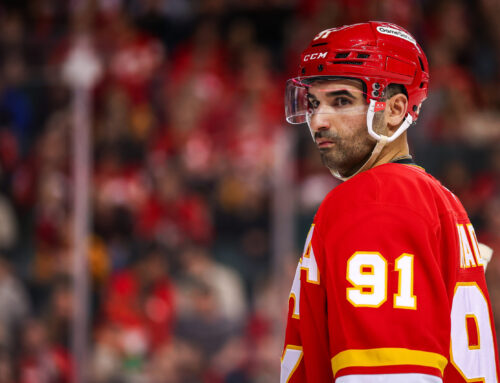As a huge fan of westerns, I have been dying to use the title for an article, and this feels like the perfect opportunity. This week, we are going into some of the most intriguing team statistics of the season, the best, the worst, the downright ugly, and even a few surprises. From unexpected leaders in rebound goals to teams thriving despite penalty troubles, each statistic paints a unique picture of a team's journey through the season and into the playoff race. With that, here are the Top 10 Team Stats.
Enjoy!
10. Goal Differential (-81) – San Jose Sharks
The San Jose Sharks have scored 189 goals (2.63 GF/G) but have given up 270 goals (3.75 GA/G), a trend typical of younger teams. This has left them with the league's worst goal differential at -81. The Chicago Blackhawks aren't far behind with a -68 goal differential. While San Jose’s power play is decent at 19.6%, their struggles at even strength, particularly in controlling the play and limiting opponent scoring, have been a key factor in their struggle this season.
9. Hits Given (1975 hits) – Florida Panthers
The Florida Panthers are leading the NHL with 1,975 hits this season, which should not surprise many given their physical style of play. Their defense focuses on forechecking and using body contact to disrupt the opposition's puck movement and force turnovers. While this strategy helps them wear down opponents and create offensive chances, it comes with a downside. The Panthers' aggressive approach results in a lot of penalties, as they sit second in the league with 589 penalty minutes, right behind the Boston Bruins (609). This leads to more time spent shorthanded, but their penalty kill has been solid, effectively handling the extra pressure.
8. Powerplay TOI (5:12 per game) – Ottawa Senators
The Ottawa Senators’ power-play TOI of 5:12 per game has been a key factor in their playoff push. Averaging over five minutes on the power play each game, they are getting plenty of chances to capitalize with the man advantage. Their PP% sits at 23.6%, which is effective but not elite in the league. Still, being on a respectable 6-4 run over their last 10 games, with 55 power-play goals (on the season) to show for it. This success on special teams has certainly helped keep them in the mix, with 84 points in the standings.
7. Goals For (266) / (264) – Washington Capitals / Tampa Bay Lightning
This race is extremely tight and can shift daily and that's exactly what happened as I wrote this. The Tampa Bay Lightning briefly held the lead for most goals scored, but the Washington Capitals reclaimed the top spot with 266 goals, averaging 3.64 per game. Close behind, and unsurprisingly, are the Lightning with 264 goals and a 3.62 goals-per-game average. By the time you read this, the standings may have changed again, and I would not be surprised if this battle for the top continues to go back and forth as the season winds down
6. Shorthanded TOI (5:20 per game) – New York Rangers
The New York Rangers lead the league in shorthanded time on ice, averaging 5:10 per game, which has been a challenge in their playoff push. While their penalty kill ranks among the top five at 82%, constant penalties put them in tough situations. Despite their strong PK, defensive consistency remains an issue. With 77 points, they are in a competitive spot, but cutting down on penalties would help. Less time shorthanded would allow them to focus more on five-on-five play, where they need to improve if they want to solidify their standing down the stretch.
5. Rebound Goals For (28) – Vegas Golden Knights
The Vegas Golden Knights are leading the NHL with 28 rebound goals this season, accounting for 17.1% of their total goals on the season (250). Their relentless pressure in the offensive zone forces turnovers and creates multiple shot opportunities, boosting their chances of capitalizing on rebounds. Last season, they ranked 11th with 25 rebound goals. This high rebound goal rate hinges on their ability to maintain consistent offensive pressure and disciplined play, which appears sustainable for now. If they can keep up this approach, their current success in generating rebound goals should continue to be a key part of their offensive strategy.
4. Even Strength Goals (215) – Washington Capitals
If we had talked about this at the start of the season, you might have been surprised, but looking at the standings now, it makes sense. The Washington Capitals are averaging over 3 goals per game (3.64 GF/G) and have been highly effective at even strength. Their offensive depth has been a major factor, with offseason additions like Jakob Chychrun, Andrew Mangiapane, and a revitalized Pierre-Luc Dubois making a real impact. Plus, the younger core of Aliaksei Protas and Connor McMichael has contributed to their success. Oh of course, we cannot overlook Ovi's chase for the scoring title, it has been a huge driving force for this team’s offense.
3. Power-Play Goals (61 Goals) – Detroit Red Wings
The Detroit Red Wings’ power play has been a key reason they have stayed competitive, with 61 goals and a 28.9% success rate placing them among the league’s best. This efficiency has helped balance their even-strength struggles and a negative goal differential (-22). However, sustaining this level of power-play success remains uncertain. With playmakers like Lucas Raymond, Dylan Larkin, Alex DeBrincat, and Patrick Kane, their unit is dangerous, but these numbers often fluctuate. Given their overall offensive inconsistency (2.88 GF/G) and negative goal differential, keeping up this production will be a significant challenge as the season progresses.
2. Blocked Shots (748) – Carolina Hurricanes
The Carolina Hurricanes may rank near the bottom in blocked shots this season (748), but that reflects their proactive defensive style. Unlike teams such as the Philadelphia Flyers (1,203 blocked shots), the Hurricanes focus on limiting shot opportunities rather than relying on blocks. Their defensive system emphasizes strong gap control, structured zone coverage, and an aggressive forecheck, all designed to reduce shot volume. Solid goaltending also plays a key role, with their netminders handling low-percentage chances and controlling rebounds. This disciplined approach allows them to maintain an effective defense without constantly throwing bodies in front of shots.
1. Overtime Losses (13) – Vancouver Canucks
The Vancouver Canucks’ 13 overtime losses have played a crucial role in keeping them in the playoff race, adding 13 extra points to their total. With 81 points, those losses have kept them competitive, without them, they would have just 68 points and likely be out of contention. On the other hand, converting those overtime losses into wins would have put them in a much stronger position. They have played many tight games, averaging 2.88 goals for and 3.09 goals against per game. While easier said than done, they need to start closing out games in regulation instead of relying on overtime for points.
Thanks for reading! See you next week. For more content/fantasy hockey analysis, follow and message me on X @Punters_hockey





 EDM
EDM TOR
TOR PIT
PIT VAN
VAN FLA
FLA MIN
MIN DET
DET COL
COL CAR
CAR
